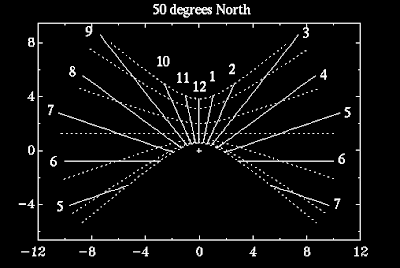This blog is used to highlight things I like and stuff I did. A digital diary for sharing.
Friday, September 17, 2010
Time Keeping and Sundials
MORE?
The History of Timekeeping
The most ancient way of keeping time during the day is to see where the Sun is in the sky. If you live north of the equator, then the Sun rises toward the east, reaches its highest point in the sky (culminates) due south, and sets toward the west, so it moves along the sky from left to right. Of course, there are no hour markers in the sky, so time you tell from the Sun's position in the sky is only a guess. The second most ancient way of keeping time is to watch the shadow of something like a stick or tree move along the ground. Because the Sun moves from left to right in the sky (to the north of the equator), the shadow rotates in what we now call the clockwise direction. You can put marks on the ground to indicate different hours, and then you have something that looks like a clock. Because the height of the Sun above the horizon changes all the time, the speed of the shadow's rotation varies all the time, both with the time of day and also with the seasons. This means that the "hours" of this clock (as indicated by the marks on the ground) do not keep the same length all the time.
The next improvement is to tilt the thing that casts the shadow and/or the surface that the shadow falls on so that the rotation speed of the shadow on the surface is most closely constant. Such a device is called a sundial. Unfortunately, however, a sundial does not work if there is no sunlight due to clouds or nightfall, and is very hard to use on boats, where there usually is no steady surface. For the same reason, wrist-sundials did not become very popular.
Finally, if you remove the thing that casts the shadow, replace the shadow by a clock hand, and put some machine behind it that makes the hand move at the right (constant) rate, then you have a clock: a mechanical device that keeps time and that resembles a sundial in the way you read it.
The hands of a clock move in what we now call the clockwise direction because shadows to the north of the equator, where modern clocks were invented and from where they spread around the world, move in that same direction. South of the equator, shadows move in the opposite direction, so if modern clocks had been invented in Argentina or Australia or South Africa and then spread around the world, then the hands of clocks would have moved in what we now call the counterclockwise direction - though of course that direction would then have been called clockwise.
Sundials
Simple vertical sundial
There are many different kinds of sundials. The simplest of sundials is a straight stick that is planted vertically in a horizontal patch of ground. This type of sundial has a venerable history, because it was used by an ancient Greek astronomer to measure the size of the Earth. You have to read out such a sundial by looking at the position of the end of the shadow of the stick. The direction alone of the shadow is not enough, because that depends on the changing time of day as well as on the changing season, and you cannot disentangle these effects if you have only the direction available.
You can see what kind of paths the end point of the shadow traces in plots for the equator, for 30 degrees latitude, and for 50 degrees latitude. The numbers along the axes show the distance to the sundial in units of the length of the sundial above the ground. The solid lines show where the endpoint of the shadow is at a particular hour (solar time), and the dotted lines show the path that the endpoint traces on particular days. The topmost dotted line is for Northern midsummer (around 21 June), the horizontal line is for the equinoxes (around 21 March and 23 September), and the bottommost line is for Northern midwinter (around 21 December). For Southern latitudes you should flip the images over from top to bottom. The paths are clearly very dependent on your latitude and on the seasons.
Simple inclined sundial
A design that is much easier to use is one in which the axis of the sundial is parallel to the rotation axis of the Earth at your latitude. In that case the readout of the sundial is independent of the seasons, so you need measure only the direction of the shadow but not its length.
The basic idea is to attach a circle to a stick such that the stick points straight through the center of the circle, perpendicular to the plane of the circle. Then make the stick point North in the Northern hemisphere, or South in the Southern hemisphere, and as many degrees up from the horizon as your latitude is. If you live close to the equator, then the stick will be almost horizontal. If you live in the Northern hemisphere, then you can get the correct orientation by making the stick point at the North Star one night and keeping that orientation. Then put hour markers around the circle, dividing the whole circle up into 24 equal hours, with 12 noon at its lowest point, 6 am at the Westernmost point, and 6 pm at the Easternmost point. Then, the shadow of the stick on the circle indicates your local solar time.
Subscribe to:
Post Comments (Atom)



No comments:
Post a Comment